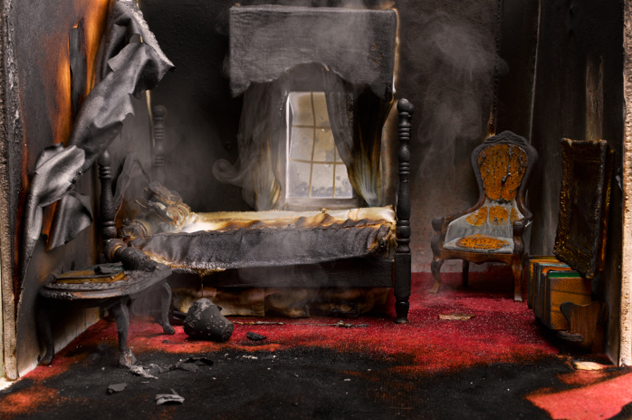 Weird Stuff
Weird Stuff  Weird Stuff
Weird Stuff  Animals
Animals 10 Terrifying Human Encounters with Swarming Animals
 Mysteries
Mysteries 10 “Ancient Alien” Artifacts That Have Mundane Explanations
 Miscellaneous
Miscellaneous 10 Everyday Terms with Surprising Historical Origins
 Humans
Humans 10 Genius Inventors with Highly Suspicious Deaths
 Weird Stuff
Weird Stuff 10 Weirdest Concept Car Designs Ever
 Movies and TV
Movies and TV The 10 Most Memorable Commercials of All Time
 Crime
Crime 10 Shocking Facts About the Electric Chair
 History
History 10 Cool Gold Rushes They Don’t Teach in History Class
 Pop Culture
Pop Culture Science Fiction’s Ten Coolest Spaceships
 Weird Stuff
Weird Stuff 10 “Mysteries” That Prove We Live in Weird & Awful Times
 Animals
Animals 10 Terrifying Human Encounters with Swarming Animals
 Mysteries
Mysteries 10 “Ancient Alien” Artifacts That Have Mundane Explanations
Who's Behind Listverse?

Jamie Frater
Head Editor
Jamie founded Listverse due to an insatiable desire to share fascinating, obscure, and bizarre facts. He has been a guest speaker on numerous national radio and television stations and is a five time published author.
More About Us Miscellaneous
Miscellaneous 10 Everyday Terms with Surprising Historical Origins
 Humans
Humans 10 Genius Inventors with Highly Suspicious Deaths
 Weird Stuff
Weird Stuff 10 Weirdest Concept Car Designs Ever
 Movies and TV
Movies and TV The 10 Most Memorable Commercials of All Time
 Crime
Crime 10 Shocking Facts About the Electric Chair
 History
History 10 Cool Gold Rushes They Don’t Teach in History Class
 Pop Culture
Pop Culture Science Fiction’s Ten Coolest Spaceships
10 Terrifying Tales Of Violent Poltergeists
Usually, the biggest danger you face with a ghost is the need to change your underwear. But the tormented spirits of the dead aren’t always friendly. As we learned from that movie with Patrick Swayze, sometimes the dead can learn to interact with our world. These restless spirits are called poltergeists, and according to the stories, sometimes they can be incredibly violent. The ghosts in this list are ones you definitely don’t want hanging around your kitchen.
10 Greyfriars Cemetery

Greyfriars Cemetery, in Edinburgh, is home to a ghost with a terrible reputation. It’s the location of the tomb of George Mackenzie, a 17th-century Scottish lawyer. He was responsible for 18,000 opponents of King Charles II being put to death, which earned him the nickname “Bluidy Mackenzie.”
Back in 1999, a homeless man broke into the tomb in order to find shelter from the cold. Then he climbed into the coffin, and it all went wrong. The coffin crumbled all over the terrified man, and he ended up running away, covered in the dust of the long-dead man. This thoroughly terrified a dog walker, who probably thought he was seeing a ghost. But the real ghosts were yet to come.
People soon started making claims about unusual activity around the tomb. The city council closed the cemetery to the public until local tour guide Jan-Andrew Henderson set up an official ghost tour. Since then, 350 people claim to have been attacked by a poltergeist around the tomb. There have been stories of broken bones caused by the spirit, and 170 people have passed out during the tour.
There’s another grave at Greyfriars that could well be the cause of the evil force. Harry Potter fans have been visiting the cemetery to lay messages beside the grave of a man named Thomas Riddell, the original name of Lord Voldemort. J.K. Rowling has said that the grave may well have been a subconscious influence in her choice of name. Or perhaps Thomas Riddell really was an evil wizard, and Rowling knows more than she’s letting on.
9 The Black Monk Of Pontefract

An unassuming, semi-detached house in the English market town of Pontefract was the host of “the most violent poltergeist haunting in European history” in the 1970s, according to some sources. The ghost was known as the Pontefract Poltergeist, but was also nicknamed the Black Monk of Pontefract due to a belief that it was the spirit of a monk killed during the 16th century.
Number 30 East Drive was the home of the Pritchard family—Joe and Jean, along with their son Philip and daughter Diane. The family says they were tormented by a wide variety of problems from a ghost they nicknamed “Fred.” He threw objects around, made rooms colder, and left puddles on the floors. He also took bites out of jam sandwiches and smeared stuff on door handles. Fred could also apparently teleport eggs from room to room (before smashing them, of course).
However, Fred wasn’t always the supernatural equivalent of a hyperactive pet dog. One of the scariest incidents involved him dragging Diane, then aged 12, upstairs by her neck. He apparently left handprints on her neck. The ghost also tried to strangle Diane with an electrical cable. The house received visits from the local mayor, the police, and large numbers of curious psychics and self-proclaimed paranormal researchers.
One person who’s convinced the stories are true is Carol Fieldhouse, who lives next door. Her house is joined onto number 30, and the ghost occasionally wanders into her quarters. Carol claims to have met and spoken to Fred, though he generally just comes by to stare at her menacingly. She says he’s about 1.65 meters (5 ft 5 in) tall.
As for Number 30, it’s currently empty, and the Black Monk likes it that way. According to Carol, “He has already told us that whoever moves in, he will have gone in 12 months.”
8 The South Shields Poltergeist

A short distance north of Pontefract is the town of South Shields. It was here, in the summer of 2006, that a young couple and their three-year-old son were terrorized by a nasty spirit. Their real names haven’t been revealed, but they’re typically known as Marc and Marianne.
The haunting began in December 2005 with the otherworldly feng shui typical of poltergeist infestations. The spirit stacked chairs, moved chests of drawers, and slammed doors. But this wasn’t any old ghost—it was malicious and it meant business. And it had access to something the family hadn’t counted on: small, cuddly toys.
One night in bed, Marianne felt her son’s toy dog hit her on the back of the head. She sat up and turned on the lights just in time to see a second stuffed dog flying in her direction. The couple cowered under the duvet, but felt something trying to pull it away. All of a sudden, Marc yelled in pain, and 13 scratches appeared on his back. The scratches were gone the next morning.
While the poltergeist had shown that it could cause direct physical harm to humans, it seemed determined that toys were the way to go. It hung a rocking horse from the ceiling by its reins, then it placed a large, cuddly rabbit in a chair at the top of the stairs—with a sharp box cutter in its adorable paws. The ghost left messages on the young boy’s whiteboard, and even sent text messages (that couldn’t be traced to any phone or computer in this world). They were typically threatening messages, like, “You’re Dead.”
Even the couple’s three-year-old son sometimes went missing. He would be found hiding in random parts of the house, cuddled up with his blanket. They found him in a closet once, and hiding under a plastic table another time. That’s a thing that all children of that age manage by themselves, but the couple blamed their infernal houseguest.
The family called in paranormal researchers Mike Hallowell and Darren Ritson. The experts determined that even though Marc was the sort of person who seemed like he liked to play pranks, the ghost was real. Then they wrote a book about it. Among the things you can see on the book’s website are a picture of a plastic bottle poised in an “impossible” way, and a message on a magnetic drawing toy that says, “Just go Now.”
7 The Coventry Dog Killer
A family in the English city of Coventry made headlines when they posted the above video online. If you can’t watch it, it shows a wardrobe door opening, and a chair moving across a room by itself. What the video doesn’t show is the floor, or the inside of the wardrobe. Yes, the whole thing could’ve been done by tying some string to a chair leg—but who would go to such costly and elaborate lengths to acquire time in the spotlight?
Coventry resident Lisa Manning claimed that the phenomena was genuine, and that the poltergeist killed the family’s otherwise healthy dog by pushing it down the stairs. To validate her claims, she called upon one of the UK’s most prominent psychics, Derek Acorah. While Acorah has been known to channel dogs from the afterlife, he only spoke to the ghost on this occasion.
The psychic-for-hire reported that an angry spirit named Jim was behind the trouble, and cleansed the house. Manning was very happy with the results, saying, “It’s amazing how quick it’s happened. I’m quite happy to stay now.”
6 The Indianapolis Poltergeist

In 1962, three generations of women lived together at 2910 North Delaware Street, Indianapolis. The head of the house was divorcee Renate Beck. She shared the home with her mother, a widower, and her teenage daughter, Linda. By all accounts, the three women didn’t get along, and would regularly fight. However, what little peace they had was shattered by a string of unusual activity that began the evening of March 11.
The first thing the women noticed was a beer mug moving by itself and hiding behind a plant pot. Later, a large bang came from upstairs, and the women found that a crystal ornament had been thrown several feet from a shelf and smashed into pieces on the floor. The three of them left the house and spent the night in a hotel. When they returned the following afternoon, everything was fine—for about 30 minutes. Then the women heard sounds of breaking glass coming from the kitchen, and found their glasses and crockery being smashed. A cup flew through the air and narrowly missed Beck’s mother, Lina Gemmeck.
The women called the police. Over the following couple of weeks, officers regularly visited the property to try to figure out what was smashing up the place. A paranormal investigator was called in, and claimed to have been bruised by a glass that was thrown down a hallway by an invisible hand.
A series of bites and scratches appeared on the women of the house, similar to those that would be caused by a bat. The possibility of an actual bat was dismissed—while there are bats in Indiana, they hibernate in winter. No effort was made to rule out the presence of a shape-shifting vampire.
Eventually, police officers caught Gemmeck throwing objects at walls and overturning furniture. She was arrested, though several people claim that they had experienced activity that she couldn’t possibly have caused. Perhaps she’d been possessed by the original culprit. In any case, a judge agreed to drop the case if Gemmeck moved back to her native Germany. She agreed. After she left, the paranormal activity stopped.
5 The Great Amherst Mystery

On September 4, 1878, Esther Cox woke up screaming in her bedroom in Amherst, Nova Scotia. The 19-year-old shared a room with her sister Jennie, and when she calmed down she complained that she’d felt a mouse under her mattress. The two girls lived in the house of their elder sister and her husband, Daniel Teed. Daniel’s brother John Teed was also living there.
The sisters searched, but the room appeared to be suspiciously rodent free. Then, the same thing happened the next night. Again they searched, and again they found nothing. Then, on September 6, Esther awoke in pain, her entire body swelling and turning bright red. A series of loud bangs echoed through the room, after which Esther returned to normal and fell asleep.
The same thing happened again a few days later, but this time other family members heard the commotion and rushed into the room. Esther’s bedding had been torn from her bed by an unseen force and thrown around the room. John Teed was among the first there, and he tried to help put the bedding back on, but ended up in a battle of wills with whatever invisible force wanted to keep the beds unmade. The poltergeist also attacked John with a pillow. After everyone heard a few more sudden explosions, everything went back to normal.
The family called their physician, Dr. Carritte. The doctor stayed in the room when Esther went to bed. When the young woman’s pillow began sliding around under her head, Carritte tried to hold onto it, but his invisible opponent was stronger. During the pillow-tugging contest, Carritte heard scratching and saw a message slowly appear in the wall, carved by an invisible instrument: “Esther Cox, you are mine to kill!”
In the following weeks, the poltergeist began setting small fires. He threatened to burn the house down unless Esther left, so she went to stay at a local inn with a friend of the family. The poltergeist followed, and Esther was seriously injured when a pocket knife flew from the hand of the innkeeper’s son straight into Esther’s back. When the boy tried to pull it out, it was again yanked from his hand and plunged into the same opening. The wound became infected, and Esther barely survived the following weeks.
When she was well again, Esther met a man named Walter Hubbell, and he had the worst idea in history. He took Esther to New Brunswick and put on a show, charging people to come and witness the spooky phenomena. The poltergeist never made a peep in front of the audience. The world’s most boring theater piece was chased out of town, and the two were forced to abandon the project.
Esther then got a job as a domestic helper for a local court clerk, Arthur Davison. Esther had only been there a few months when their barn burned down. The young woman was blamed for starting the blaze, but she insisted that it was actually her poltergeist stalker. The judge wasn’t impressed, and Esther was convicted of arson.
The poltergeist became gradually less active, and went away as mysteriously as it had turned up. Esther married twice, and died in 1912.
4 The Jaboticabal Poltergeist

In 1965, an 11-year-old named Maria Jose Ferreira was subject to the most infamous poltergeist in the history of Brazil.
It began in her house in the city of Jaboticabal, when bricks and stones began to materialize out of thin air and smash things. Maria’s family called in a priest to do an exorcism. This only angered the spirit, and the onslaught got worse. The largest rock found was 3.7 kilograms (8.2 lb), and some of the stones were magnetic. When the rocks eventually stopped appearing, furniture started being thrown around.
Maria had it even worse than her house. She was slapped and bitten, and ended up with all sorts of bruises. Needles suddenly appeared embedded in Maria’s skin. On one occasion, 55 had to be removed from a single ankle. The poltergeist held cups over her face to suffocate her in the night. The problems followed her to school, and at one point her clothes spontaneously caught on fire in the lunch room. The attacks went on for a year before Maria went to see a medium.
The psychic said that Maria was being attacked by an angry ghost because she had been a witch in a previous life. During her witchery, she had killed a person, and that person’s spirit held a grudge. The ghost planned to haunt Maria for her entire life. That life was, sadly, short. Maria poisoned herself when she was 16. When she was gone, all activity stopped.
3 Stoke Lacy’s Haunted Road

Back in 2002, a fence seems to have lost an argument with a ghost in the English village of Stoke Lacy. At least, that’s the best explanation for the fact that a spirit is reported to have crashed 26 cars into the same fence in an 18-month period.
Many of the drivers reported a sensation of having their hands pulled away from the steering wheel just before they veered off course. Others claimed that their wheels simply didn’t respond. Some cars rolled over, yet there wasn’t a single injury. This fact was made even stranger by the words of a mysterious psychic.
A local councilor, Richard James, said he’d been approached by a man he didn’t recognize at a meeting in the local pub. The strange old man told the councilor that he was a psychic, and that a woman had died at the accident hotspot in the 1930s. She’d been killed in a car accident after a fight for control of the steering wheel. She wished to inflict the same fate on other motorists, but had promised that she won’t let anyone get hurt. That’s good news for people, and bad news for the fence.
2 Carole Compton

Many poltergeist stories suggest that the phenomena may be being caused, subconsciously, by a person with some sort of latent psychokinetic ability. That is, they can move things with their mind, but not consciously control their power. At least, that’s what seems to have happened to Carole Compton.
In the early 1980s, Compton worked as a nanny in Italy, but it didn’t go well. When she was with her first family, a painting fell from the wall when she walked by. She went to stay with them at their holiday home in the Alps, but that burned down during their vacation. When the family returned home, random fires began appearing around the house. The family eventually let Compton go when a fire started in their son’s room.
The young Scot found another job with the Tonti family. It didn’t take long before household objects began flying around, and a mattress caught on fire. Presumably, the Tontis hadn’t asked for a reference, because this didn’t cause them to sack Compton immediately. That happened when fire engulfed the room of their three-year-old daughter, Agnese. The family had Compton arrested, and she was charged with arson and attempted murder (luckily, no one was hurt during any of these fires).
The trial became a media circus. The public perception was that she was a sorceress, an accusation made by Agnese’s grandmother. Catholics gathered outside the court, crucifixes in hand, and chanted prayers. International press coverage called the event a witch trial. Guy Lyon Playfair, a parapsychologist whose investigation of Britain’s infamous Enfield poltergeist earned him a Wikipedia page, offered to fly out and help defend Compton.
The trial took 16 months, during which time Compton was kept in prison. No one had actually witnessed her starting a fire, which made the prosecution’s job difficult. Fire and falling things just seemed to follow the young woman. Eventually, she was convicted of arson, but the attempted murder charges were thrown out. The judge decided that the 16 months she’d already spent inside were punishment enough, and she was released.
Compton moved back to the UK and wrote a book about the events, Superstition: The True Story Of The Nanny They Called A Witch.
1 Widow Ghosts

Nightmare Death Syndrome is a phenomenon reported among certain men of Thailand, who are apparently being killed in their sleep by spirits known as “widow ghosts.” These are said to be the ghosts of particularly sexual women who met a violent death. Now, they’re out to kill men and take their souls as husbands.
A widespread panic over the widow ghosts broke out in northeastern Thailand in 1990. Since the ghosts only attacked men, some young Thai fellows took to wearing lipstick and nail polish in bed in order to trick the spirits into thinking they were actually women. Yet the main strategy for warding off the ghosts was penises hung around the neck or in close proximity to the sleeping man.
Most were carved from wood, some more crude than others. Some artistic types added testicles made of coconuts, and pubic hair made from fishing nets. The residents of Ban Thung Nang Oak were very proud of their giant communal phallus, which was almost a meter (3 ft) long and had a red tip.
One couple crafted an entire scarecrow with the relevant appendage, and hung a sign around its neck that read “widow ghost hunter.” In one village, there were rumors that the ghosts had finally acquired enough husbands, and the spirits were going to start seeking out female companions as well.
There’s actually a proper explanation for these ghost attacks, which have caused hundreds of deaths over the years. Autopsies revealed that the men had died due to poor nutrition. Many lived on a diet of nothing but sweet rice, which led to overproduction of insulin and a bunch of nutrient deficiencies. Combined with stress, the awful diets were enough to kill men in their sleep.
Alan lived in South Shields in the summer of 2005, a year before the poltergeist turned up. He denies the constant accusations that he may have opened a portal to Hell and swears he had nothing to do with any ghosts. You can haunt him on Twitter.








